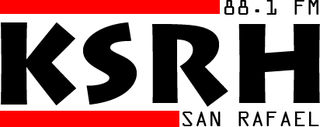Lorenzo Wilson Milam, born on August 2, 1933, in Jacksonville, Florida; died on July 19, 2020, in Puerto Escondido, Oaxaca, Mexico, was an American writer and activist who was instrumental in starting many of the first listener-supported community radio stations in the United States, beginning with KRAB in Seattle in 1962. [1]
In 1952, at age 19, he was diagnosed with polio. His sister died of the disease on December 29, 1952, but Milam's case was milder and he was able to walk with crutches after one year. This and the aftermath are described in his autobiographical book "The Cripple Liberation Front Marching Band Blues." [2]
Milam is credited with helping start 14 stations from the early 1960s through late 1970s. [3] He got his start in radio volunteering in 1958–1959 at Lew Hill's KPFA in Berkeley, California. He used a $15,000 inheritance to buy a small FM transmitter in 1959 and spent the next 3 years seeking a broadcasting license "anywhere in the US" from the Federal Communications Commission (FCC), which assigned him a frequency in Seattle, 107.7FM. [4] With the help of volunteer engineer Jeremy Lansman he was able to get his antique Collins Radio transmitter on the air in 1962, creating the station KRAB. [5] [6]
Milam and Lansman later assisted in the creation of community radio stations around the country, starting in 1968 with KBOO (1968-1971) in Portland; [7] KTAO (1968-1974); KDNA (St. Louis) 1969-72;KPOO (1972-) San Francisco;, KCHU, 1975-77; KFAT (1975-1983) Gilroy, California; WORT; WRFG 89.3 FM (Atlanta, Georgia); KOPN 89.5 FM (Columbia, Missouri); KZUM 89.3 FM (Lincoln, Nebraska). [8]
The KRAB Nebula, was a tape exchange, using quarter-inch audio tape sent to stations, sharing programs. [9]
According to David Armstrong in A Trumpet to Arms: Alternative Media in America, "Milam's passion for community radio--and 1.1 million from the sale of a second station, KDNA-St.Louis, to commercial broadcasters in 1973--led him to become a veritable Johnny Appleseed of community radio." [10]
Milam authored the 1971 book Sex and Broadcasting, A Handbook on Starting a Radio Station for the Community. [11] [12] [13] [14]
In December 1974, Milam and Jeremy Lansman, both radio broadcast consultants in California, sent a petition, RM-2493 to the Federal Communications Commission asking for a freeze on new licenses for educational television and radio channels, and an investigation into religious broadcasters. Although the agency did not consider the petition (on First Amendment grounds), the FCC received over a million letters, about 3,000 per day for many months, protesting the petition, the largest number of letters that the FCC has ever received on an issue. [15]
Milam published 13 issues of the print publication The Fessenden Review between 1985 and 1989. [11] Content was eclectic to an extreme degree, and as likely to confound readers as to amuse them. Issues were released at successively longer intervals as finances dwindled, and later issues were irregularly numbered. Milam hoped that anyone chancing upon a copy at a newsstand would assume it was the current issue and buy it, and that confused dealers would be less likely to identify culls.
Milam, as Publisher/Editor, produced 294 online issues, 1994-2019, of the online publication RALPH: The Review of Arts, Literature, Philosophy and the Humanities. [11] [16] [17] [18]
(this list is incomplete) [11]
Presented to the School of Journalism and Communication and the Graduate School of the University of Oregon in partial fulfillment of the requirements for the degree of Doctor of Philosophy Spring 2007
I was a student at Antioch College, and my personal interest in sociology and mass communications brought me to WYSO, the campus station. Though not a community licensee, much of the programming was produced by local volunteers, and the college itself was becoming a hub for alternative media — not only radio, but also film, video, photography and journalism. It was here that I first heard of The KRAB Nebula tape exchange, ¼-inch audio tapes that were being sent between stations to share programs, which we aired on WYSO. It was also where I met Jeremy Lansman, who put a copy of the Sex and Broadcasting booklet in my hands.
The pamphlet was an underground smash, and Lorenzo produced a second edition of Sex and Broadcasting in 1974 as an actual book (Dildo Press; with 20 pages on How to Start a Station and 300 pages of his musings and essays from the KRAB Program Guide).

AM broadcasting is radio broadcasting using amplitude modulation (AM) transmissions. It was the first method developed for making audio radio transmissions, and is still used worldwide, primarily for medium wave transmissions, but also on the longwave and shortwave radio bands.

KYXY is a commercial radio station owned by Audacy, Inc. KYXY is licensed to San Diego, California, with its studios in the city's Stonecrest area. Its transmitter site is in La Jolla, on the KGTV Tower which it shares with KGTV and several other San Diego FM stations. KYXY airs an English-language mainstream adult contemporary radio format.
KOGO is a commercial AM radio station in San Diego, California. The station airs a news/talk radio format and is owned by iHeartMedia, Inc. The station's studios and offices are located in San Diego's Kearny Mesa neighbourhood on the northeast side.

KIOI is a hot AC-formatted radio station licensed to San Francisco, California and owned by iHeartMedia, Inc. The radio studios and offices are in the SoMa district of San Francisco.

KPOO is a community radio station licensed to San Francisco, California, United States. The station is owned by Poor People's Radio. It broadcasts from a building in the Fillmore district.

KNDD is a commercial radio station in Seattle, Washington. It is owned by Audacy, Inc. and airs an alternative rock radio format. Its studios are located on Fifth Avenue in Downtown Seattle. The station broadcasts with an effective radiated power (ERP) of 68,000 watts. It transmits from a tower 707 meters (2,320 ft) in height above average terrain (HAAT) near Issaquah, Washington, on Tiger Mountain.
The National Federation of Community Broadcasters (NFCB) is a national membership organization of community-oriented, non-commercial radio stations, media organizations and producers committed to community radio in the United States.

KBOO is a non-profit organization, listener-funded FM Community radio station broadcasting from Portland, Oregon. The station's mission is to serve groups in listening areas who are underrepresented on other local radio stations and to provide access to the airwaves for people who have unconventional or controversial tastes and points of view. It broadcasts 24 hours a day, seven days a week, and has been on the air since 1968.
KLVM is an FM radio station broadcasting a Contemporary Christian music format. Licensed to Santa Cruz, California, United States, the station is an affiliate of the K-LOVE Christian music radio network and is owned by Educational Media Foundation. The signal covers much of California's Central Coast.
KSER is a non-commercial radio station and airs a mix of music and news/public affairs. The station, which is owned and operated by the non-profit KSER Foundation, broadcasts at 90.7 MHz with an ERP of 5.8 kW and is licensed to Everett, Washington.

KRUZ is a commercial FM radio station that is licensed to Santa Barbara, California and broadcasts a classic hits radio format throughout Santa Barbara, Ventura, and San Luis Obispo counties. The station is owned by Cumulus Media and has its studios in Ventura.
Free Radio San Diego was an unlicensed radio station located in San Diego, California. The founders claim that its creation was a reaction to Federal Communications Commission restrictions on new radio licenses. They provided a commercial-free unlicensed broadcast beginning on October 13, 2002 — with occasional interruptions due to FCC raids and technical issues. The open-format music selection was chosen by DJ preference but was weighted towards punk rock. Also featured were syndicated news programs such as Democracy Now! and Free Speech Radio News.
KBAY is a commercial radio station licensed to Gilroy, California, serving San Jose and the San Francisco Bay Area, broadcasting a country music radio format. KBAY is owned by Alpha Media, along with sister station 106.5 KEZR. The radio studios and offices are located off U.S. Route 101 and Hellyer Ave in South San Jose.

KOPN is a non-profit community radio station in Columbia, Missouri, United States, which from its start was modeled on the progressive format of KPFA in Berkeley, California. The station relies heavily on volunteers for programming and also carries programming from National Public Radio, Public Radio International, and Pacifica radio network.
KCHU is a non-commercial radio station in Valdez, Alaska, United States. Through its main transmitter, two full-service FM stations, and two translators, the station covers an area the size of the state of Ohio, but with a population just over 10,000.
KJLV is a radio station in Los Gatos, California, United States, serving the San Jose and Santa Clara Valley area. It is owned by the Educational Media Foundation (EMF) and part of its K-Love network. The primary transmitter is on Blackberry Hill Road in Los Gatos. KJLV also has two booster stations on 95.3 MHz: KJLV-FM1 serving Scotts Valley and KJLV-FM2 at New Almaden.

KTAO is a solar-powered FM radio station licensed to serve Taos, New Mexico. The station is owned by Taos Communications Corporation. It airs an adult album alternative music format. The station was assigned the KTAO call letters by the Federal Communications Commission on October 6, 1986. The station is an affiliate of the syndicated Pink Floyd program "Floydian Slip."

KSRH("The Sound Difference") is a low power non-commercial radio station licensed to San Rafael, CA, broadcasting on 88.1 FM. The station is owned and operated by San Rafael High School, and is operated by high school students. All of KSRH's funding comes from the San Rafael School District. The station also airs PSAs which are broadcast at no charge per FCC law.
KPFZ-FM is an FM radio station that broadcasts a community radio format to Lake County, California.
KDNA was a St. Louis, Missouri freeform non-commercial community radio station from February 8, 1969 until sometime in 1972. It billed itself as "Radio Free St. Louis". The KDNA call letters are currently used by a different station, a Spanish language station at 91.9 FM in Yakima, Washington, and the 102.5 FM frequency in St. Louis is currently occupied by a commercial station with the call letters KEZK-FM which broadcasts in the "Adult Contemporary Format".